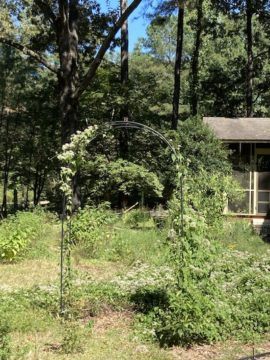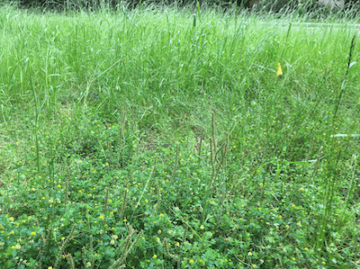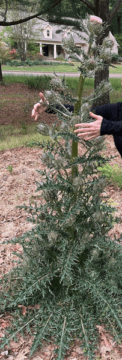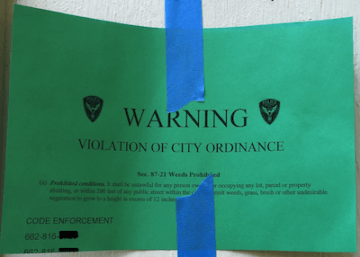by Deanna K. Kreisel (Doctor Waffle Blog)
 It had been a long time since I thought about lawns. I don’t mean in a grand philosophical sense, or the stoned contemplation of a single blade of grass. I mean thought about them at all. Before moving to Mississippi we had lived in Vancouver for 13 years, where we felt lucky to have a place to store our toothbrushes and maybe an extra pair of slacks; we really hit the jackpot when we acquired a postage-stamp-sized balcony on which we could murder tomato plants. Actual yards were out of the question for anyone who hadn’t bought a house on the west end of town 30 years ago; by the time we moved to Vancouver in 2006 as a tenure-track assistant professor and a trailing-spouse adjunct, it was already clear that we would never own a lawn.
It had been a long time since I thought about lawns. I don’t mean in a grand philosophical sense, or the stoned contemplation of a single blade of grass. I mean thought about them at all. Before moving to Mississippi we had lived in Vancouver for 13 years, where we felt lucky to have a place to store our toothbrushes and maybe an extra pair of slacks; we really hit the jackpot when we acquired a postage-stamp-sized balcony on which we could murder tomato plants. Actual yards were out of the question for anyone who hadn’t bought a house on the west end of town 30 years ago; by the time we moved to Vancouver in 2006 as a tenure-track assistant professor and a trailing-spouse adjunct, it was already clear that we would never own a lawn.
And yet here we are: the proud owners of nearly an acre of chemical-soaked herbage dotted here and there with scrubby flowering bushes native to an ecosystem half a planet away. Or at least that’s what came along with our new house in Mississippi, which was the main attraction: a 1962 bungalow with two fireplaces, built-in bookcases, arched doorways, and mellow hardwood floors. To be honest, I didn’t want the lawn—or the yard at all, really. If it had been possible to purchase a mid-century gem with a porch swing and seven ceiling fans that was floating on a gossamer cloud in mid-air—basically a house from The Jetsons—I would have done so.[1] I took one look at that expanse of greenery, factored in the whole located-in-the-Deep-South element, and saw nothing but a never-ending round of backbreaking chores. And boy, was I right. But not for the reasons you might think.
Very early on in our new-house ownership, I got it in my head that I wanted to “rewild” our yard. I had been reading all about the shrinking of habitats for native birds, butterflies, and insects, and how the traditional pesticide-drenched, monoculture American lawn might as well be a stretch of asphalt as far as pollinators were concerned. I started agonizing over the fates of the hapless birds and bugs circling our yard with little tuckerbags over their shoulders, seeing nothing good for them there, and trudging on their weary way in search of the next outpost. I felt personally responsible for them somehow, even though had I never moved to Mississippi and purchased this lawn, it would doubtless have remained a barren desert for wildlife through no fault of my own. But it didn’t matter—I was The Man now, the Owner, the Country Squire, the one making the decisions about whether billions of tiny creatures lived or died on my watch. The buck—and the doe—stopped here.[2]
The spouse and I moved into our new homestead at the end of July 2019, and agreed that we would keep using the current scorched-earth landscape service for the rest of that summer, until we could get our bearings and figure out what we wanted to do with it all. Most importantly, the owner of the landscaping company had grown up in the house we just bought, so it seemed churlish to fire him as our first act as new owners. [Fun side anecdote: when he came over to discuss lawn care with us right after we moved in, he pointed to a towering pine tree in the front yard, told us he had planted it as a child 30 years ago, and then informed us that we were not allowed to cut it down. We reassured him that we would never cut down any mature trees because we were not bloodthirsty psychopaths. We clutched our bosoms sincerely and spoke in shocked tones. He fixed us with a steely gaze. We returned it unwaveringly, pure of heart. He nodded briefly. The next spring, we engaged a tree service dude who informed us that several tall pines on the other edge of the property were too close to a 200-year-old oak tree and starving it of nutrients, so we allowed him to cut them down to save the oak. I can only imagine what Landscape Son—by that point, long since let go—must have thought as he drove by our house and witnessed that particular event.]
The following spring, you may recall, there was a global pandemic.[3] It was the perfect time to begin our new 1850s prairie homesteading off-the-grid pesticide-free lifestyle. I had spent some time over the intervening winter reading about various rewilding strategies: how to introduce and support native plants, cultivate prairie grasses, achieve chemical-free weed control, plan your own butterfly garden. But the approach that appealed to me the most was: do nothing. A couple of websites I read advocated simply sitting back, refusing to mow, and waiting to see what happened. One blogger claimed that after a few months of complete lawn-and-garden slackerdom he noticed native orchids blooming in his yard. Orchids! Now, this was a gardening strategy I could get behind. So we set our intention to do nothing, informed our lawn in writing that we would like it to become a beautiful native meadow, and waited.
After the orchids failed to appear, I went back to the original blog and noticed that the writer lives in the midland counties of England, a country whose last square millimeter has been under relentless cultivation for the past 1000 years. Sure, if you live in what is essentially an island-sized lidless terrarium, you can probably just sit around and wait for rambling roses, sweet honeysuckle, and fields of bright wildflowers to pop up “naturally” the second you turn your back. But here in Mississippi, where our dominant plants include kudzu, poison ivy, and a merciless creeper called Kill-Your-Puppy[4], you probably have to intervene a bit in your rewilding project if you don’t want to be strangled in the night by murderous vines.
But I am getting ahead of myself a little. That first spring of doing-nothingness, we did enjoy an initial brief period when promising things started to sprout from the wastes: sweet violets, tender young grasses, tiny wild strawberries. It was a genuinely exciting time—I would wake up each morning and wander into the front yard with my first cup of tea to see what had sprung up on our estate overnight. It all looked great to me; if it had cute little leaves and/or a flower of any kind, I was on board. Later I learned that most people in our area consider the things I was cooing over to be noxious pests.  I now think back on my exultant Instagram photos of burgeoning weeds—thistle and clover and dog fennel and purslane—with acute embarrassment; it was as if an alien freshly landed on earth mistook a garbage dumpster for a luxury hotel suite, or Mitch McConnell for a human being. To be clear: I am not embarrassed that I found these plants fascinating and attractive; I’m embarrassed that I tried to involve hardbitten suburban gardeners in my enthusiasm. But for weeks I walked around in an infatuated daze, forcing everyone I ran into to agree that my lawnful of weeds was beautiful.
I now think back on my exultant Instagram photos of burgeoning weeds—thistle and clover and dog fennel and purslane—with acute embarrassment; it was as if an alien freshly landed on earth mistook a garbage dumpster for a luxury hotel suite, or Mitch McConnell for a human being. To be clear: I am not embarrassed that I found these plants fascinating and attractive; I’m embarrassed that I tried to involve hardbitten suburban gardeners in my enthusiasm. But for weeks I walked around in an infatuated daze, forcing everyone I ran into to agree that my lawnful of weeds was beautiful.
I have no idea how long this state of affairs might have continued. By mid-June of that year our front lawn was a genuine meadow, or at least genuinely meadow-height. We loved it, and assumed that everyone around us would love it, too—or at least not care very much about it either way. Boy, were we wrong. We went away for a couple of weeks at the end of the month to visit my family, and while we were gone we received a panicked text from our lovely across-the-street neighbors, a pair of identical twin sisters in their 70s whom we had befriended right after moving in. Apparently their visiting grandson had just mowed their lawn for them, and upon noticing that our grass was horribly overgrown, helpfully rode his mower straight across the street and mowed our lawn, too. They were abjectly apologetic, but I was devastated. It was obvious to the twins that we had been growing the meadow on purpose, but apparently to everyone else in the neighborhood it looked like the Addams Family had moved into their quiet, tree-lined cul-de-sac.
Once the beautiful waving grasses were gone, the stuff that started popping up again through the stubble was more obviously weed-esque: poison ivy, nasty-looking things with sharp serrated leaves, scrubby tangly bushy stuff with no flowers for the pollinators. In one memorable instance, a “horrid thistle” (this is really a thing) sprouted in our front yard and we allowed it to grow to 8 feet in height before reluctantly murdering it.  Clearly the “sit back and do nothing while you survey your holdings” strategy was a bust. I revisited all the rewilding websites I had ignored in my initial enthusiasm for the “do-nothing” strategy, and slowly began to realize that if I wanted a yard full of cardinal flowers, goldenrod, turtleheads, milkweed, and ox-eye sunflowers, I would actually have to acquire them, plant them in the ground on purpose, and then do something to control all the other crap that wants to choke them out. In other words—“gardening.” It turns out that rewilding is an enormous amount of work, a strategy and set of practices meant to benefit not lazy homeowners who have accidentally purchased more yard than they can handle, but rather the very creatures I was worrying about in the first place: the bugs and the birds.
Clearly the “sit back and do nothing while you survey your holdings” strategy was a bust. I revisited all the rewilding websites I had ignored in my initial enthusiasm for the “do-nothing” strategy, and slowly began to realize that if I wanted a yard full of cardinal flowers, goldenrod, turtleheads, milkweed, and ox-eye sunflowers, I would actually have to acquire them, plant them in the ground on purpose, and then do something to control all the other crap that wants to choke them out. In other words—“gardening.” It turns out that rewilding is an enormous amount of work, a strategy and set of practices meant to benefit not lazy homeowners who have accidentally purchased more yard than they can handle, but rather the very creatures I was worrying about in the first place: the bugs and the birds.
Right around this time I began to notice signs all around me of a secret society of sorts, a ragtag underground group of renegade natural gardeners right in my area. One day I varied my morning walk route and passed a lush front yard stuffed with unusual-looking plants, some trellises with weird vines crawling over them, a brace of hummingbird feeders hanging from a tree, and a sign that said “Lisa’s Meadow” prominently planted near the sidewalk. Then I started overhearing people speaking in code at the farmer’s market, using words like “monarch” and “parsley” and “hemp” that didn’t seem to make any sense in context. Finally, my friend April texted out of the blue and said she was dividing up some plants in her yard—did I want any cuttings and seedpods? I had no idea if I wanted any cuttings and seedpods, but figured it was probably a good idea to say yes. She presented me with a huge pile of mysterious-looking woody tangles and some Ziploc baggies full of what looked like dead bugs. Somewhat at a loss, I opened up the baggies and flung the contents all over our grass, and dug a bunch of holes in the ground and planted the twiggy things at random. Obviously I had no idea what I was doing, but apparently nature will find a way, because two summers later we now have blue asters and beautyberries and bee balm all over that section of our yard.
It’s been a long, slow process. I wish I could say that our yard is now a verdant lea filled with bounteous wildflowers, but it basically looks like a scrubby mess, and our neighbors still don’t like it. This past summer, while we were again out of town for a couple of weeks, a friend watching our house texted a photo of a City of Oxford citation that had been taped to our garage door.  After staring at the photo off and on for days, cheeks burning in humiliation, I decided to call the phone number on the ticket. What did I have to lose? I immediately reached a polite, slow-talking gentleman with a deepest-of-deep Mississippi accent, who informed me that he had placed the citation on the door himself. “We had a call complaining about weeds,” he explained apologetically. “I went out there myself to check it out, and, well…” he trailed off, clearly embarrassed. “I have to admit, ma’am, that they did look like weeds to me.” I told him all about our rewilding project, and listed the names of our plants and explained how they were good for pollinators. “I’m sorry we let things get so overgrown while we were away,” I apologized, and promised to tidy things up as soon as we returned. We discussed some strategies for appeasing my neighbors, like putting in some raised beds to demarcate our plantings from the rest of the yard. “You know,” he added thoughtfully, “y’all might could put up one of those signs that explains how it’s all being done on purpose.” (Well played, Lisa of “Lisa’s Meadow”!) By the end of the conversation he was thoroughly on the side of the butterflies. It was a good talk.
After staring at the photo off and on for days, cheeks burning in humiliation, I decided to call the phone number on the ticket. What did I have to lose? I immediately reached a polite, slow-talking gentleman with a deepest-of-deep Mississippi accent, who informed me that he had placed the citation on the door himself. “We had a call complaining about weeds,” he explained apologetically. “I went out there myself to check it out, and, well…” he trailed off, clearly embarrassed. “I have to admit, ma’am, that they did look like weeds to me.” I told him all about our rewilding project, and listed the names of our plants and explained how they were good for pollinators. “I’m sorry we let things get so overgrown while we were away,” I apologized, and promised to tidy things up as soon as we returned. We discussed some strategies for appeasing my neighbors, like putting in some raised beds to demarcate our plantings from the rest of the yard. “You know,” he added thoughtfully, “y’all might could put up one of those signs that explains how it’s all being done on purpose.” (Well played, Lisa of “Lisa’s Meadow”!) By the end of the conversation he was thoroughly on the side of the butterflies. It was a good talk.
But the conversation did leave me in a mild state of existential panic. What is a weed? I continue to ask myself. Having to explain why we were deliberately cultivating plants that hadn’t been developed in the colonial greenhouses of Victorian England—plants that looked kind of nasty and wild—was a slightly vertiginous experience. I thought I had a pretty good handle on why I was planting giant clover instead of geraniums. But why bergamot and not dog fennel? They’re both “native,” yet re-wilders favor the former and not the latter. Even more of a mind-fuck was the whole question of what exactly “native” means to begin with. Plants that have been here since before settler colonialism? That seems obvious enough. But what about regional boundaries? If I plant a bunch of big bluestem grass—which is native to the Midwest—here in Mississippi, am I cheating? What does it mean for a plant to be “invasive” anyway? What about ecosystems that have reconfigured themselves around introduced plants (and fungi, and animals)? If an area has reached a new equilibrium with, say, bittersweet nightshade, is it needlessly disruptive to tear it all out and force everyone to get along with a native plant instead, like a helicopter mom at a kid’s birthday party?
My explanation to the Oxford Weed Cop seems simplistic in retrospect. Even more disturbingly, at a certain point in our conversation it became clear (to me, anyway) that we weren’t talking about just plants any more. It’s impossible to have a discussion of nativeness and invasiveness and wildness in North America without simultaneously calling everything around you into question—as it should be. But such agonizings also seem like pretty weak sauce in the end. A white middle-class Yankee lectures a white born-and-raised Mississippian—using cell towers planted in soil seized through acts of genocide, enriched by the labor of enslaved people—about the importance of returning to a fantasized state of unadulterated aboriginality. A pair of know-it-all academics invade a neighborhood with their newfangled ideas and immediately alienate the neighbors who have lived there for decades. I started to become unsure which perspective was more problematic—apparently the Nazis had also advocated a rigid botanical purity based on perceived indigeneity.
What I keep coming back to, though, was the way my new pal on the phone granted me the grace of a real conversation, allowing me, for just a few minutes, to feel a tiny bit more like a local, if not exactly a native. We both cared about our town and its greenery, just in different ways. There are always going to be millions of ways that I chafe against the customs and habits of small-town Mississippi, but maybe I could start to get the hang of it, just a little. Lesson One: treat everyone like a neighbor you will have to interact with every day (because you will), talk instead of yell, sidle up on the topic slowly, feel your way to common ground.[5]
In the two years we’ve been here, new mini-ecosystems are already starting to twine around us: new friends, students, political work, kickball teams. The sharp boundaries will continue to blur, just a little. Things will burgeon, and spread, and flower, and die back, and return. One day we will be gone, and something else will be here instead. Maybe the descendants of things we planted will remain. Or maybe not.
[1] In the spirit of full disclosure, I must confess that our house also has a swimming pool. I also really, really, really didn’t want the swimming pool, which seemed excessive and expensive and ridiculous to me—like owning our own helicopter. Boy do I freaking love our swimming pool, which is unavoidably located on our lawn. So I guess what I really would prefer would be a house floating on a cloud that is attached to another cloud with a swimming pool on it.
[2] I am slightly ashamed to admit that I have become, over the course of the past couple of years, a cliché suburban home-owning deer hater.
[3] J/K! That sentence seems to imply that the global pandemic is over. LOL.
[4] This is not a real thing! I made it up. But you believed it, right? People will believe anything about Mississippi.
[5] That said, I have violated my own new rule about a thousand times since this conversation. Also, this strategy does not necessarily work with politics.
